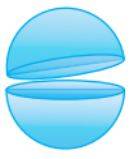
Rachit Kumar SaxenaManager-Editorial
What is Hemisphere?
A sphere is a three-dimensional object consisting of equidistant points from the centre point. A sphere, when divided into two equal parts, forms a hemisphere. It is half of a sphere, so a sphere makes two equal hemispheres. As an example, the earth is a sphere having two hemispheres, i.e., Northern Hemisphere and Southern Hemisphere.
Volume of Hemisphere
It can easily be calculated by dividing the Volume of the Sphere by two. Below is the formula to find the Volume of the Hemisphere.
Volume of Hemisphere = (2/3) πr3 cubic units
Where r = Radius of Hemisphere
π = 3.14 (is constant)
How to find the Volume of the Hemisphere?
According to the Archimedes principle, we can calculate the volume of any object by immersing it in a container filled with water. The Volume of water that overflows gives the volume of the object.
To find the Volume of the Hemisphere, we will first find the volume of the sphere. Consider a cylinder containing water filled up to the rim. Immerse a Sphere into the cylinder so that the sphere touches the cylinder from sides and from top to bottom. So, when the sphere touches the sides of the cylinder, the radii of the sphere and cylinder become the same. Also, the sphere touches the cylinder from base to top, which implies the Diameter of the Sphere, is the same as that of the height of the cylinder.
Images Source: NCERT
Consider the Volume of the Sphere as two-third of the Volume of the Cylinder.
Therefore, Volume of the Sphere=2/3(Volume of the cylinder)
=2/3πr2h
the height of the cylinder (h) is equal to the diameter of the sphere = 2r. So, we can replace h with 2r in the above formula.
Volume of sphere=2/3πr2(2r)
=4/3 πr3
Volume of Hemisphere=½(4/3πr3)
=2/3 πr3
Weightage of Volume of Hemisphere
Hemisphere volume and surface area are an essential part of Mensuration taught in class X. As part of the syllabus, students need to understand the hemisphere object and the methods to calculate the surface area and Volume using the radius.
Illustrated Examples on Volume of Hemisphere
1: What is the Volume of the Hemisphere having a radius of 11.2 cm.
Solution:
Volume of hemisphere = 2/3 πr3 = 2/3 (3.14) (11.2) 3 = 2940.98 cm3
2: How much water can a hemispheric bowl contain if the bowl has a radius of 5 cm.
Solution:
The volume of water = 2/3 πr3 = 2/3 (3.14) (5) 3 = 261.67 cm3
3: An object is in the shape of a cone placed over the Hemisphere radius of both cone and Hemisphere is 1 cm and height of cone is 1cm. Find the volume of the object.
Solution:
Height of object = Diameter of Hemisphere
Volume of object = Volume of Cone+Volume of Hemisphere
=⅓𝜋r2h+⅔𝜋r3
= ⅓(3.14)(1)(1)(2)+⅔(3.14)(1)(1)(1)
= 2.09+2.09=4.18cm3
FAQ’s on Hemisphere
Q: How to Find the Surface Area of the Hemisphere when the Hemisphere Volume is given?
Q: What is the surface area of the Hemisphere?
Surface area of Hemisphere = 3πr 2
Q: As the surface area of a sphere is not double the surface area of a hemisphere. Does this same concept apply in the case of volume too?
Volume of Hemisphere = 2/3 πr 3
Volume of sphere = 2 (Volume of hemisphere) = 4/3 πr 3
Q: Are the sphere and circle the same?
Q: How many sides are present in a hemisphere?
News & Updates
Maths Mensuration Exam
Student Forum
Popular Courses After 12th
Exams: BHU UET | KUK Entrance Exam | JMI Entrance Exam
Bachelor of Design in Animation (BDes)
Exams: UCEED | NIFT Entrance Exam | NID Entrance Exam
BA LLB (Bachelor of Arts + Bachelor of Laws)
Exams: CLAT | AILET | LSAT India
Bachelor of Journalism & Mass Communication (BJMC)
Exams: LUACMAT | SRMHCAT | GD Goenka Test


